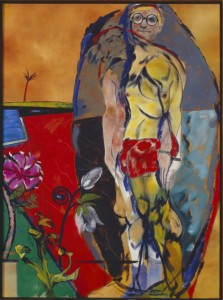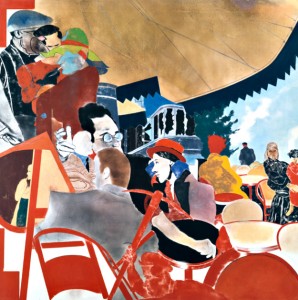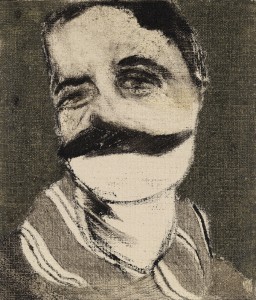
R.B. Kitaj, The Neo Cubist, 1976-1987 © R.B. Kitaj Estate, Astrup Fearnley Collection, Oslo, Norway
On the 19th of October, just past 8 pm, I received the message “David is breaking away from his installation in Köln and will arrive at the Jewish Museum on Sunday 21st. between 11. – 11.30 am.”
Some time before, I had contacted the gallerist Peter Goulds to ask whether David Hockney might be interested in coming to Berlin to visit the R.B. Kitaj exhibition; I knew Hockney would be in Cologne to open his own exhibit “A Bigger Picture” at the Museum Ludwig. Though it seemed unlikely at first, Hockney was able to come. He brought his partner, his studio manager, and a chauffer, and appeared wearing an elegant grey double-breasted suit, a black Hawaii shirt with fantastic plants on it and a checked flat cap.
→ continue reading

R.B. Kitaj, The Autumn of Central Paris (After Walter Benjamin), 1972–1973 © R.B. Kitaj Estate
Kitaj’s canvasses are riddled with references to artists and scholars, from Erasmus to Herman Melville, from Fra Angelico to Rosa Luxemburg. From a formal perspective, Kitaj’s obsessive use of citations reflects on the visual impact of images and names, signs and references. Conceptually, citations can involve finding artistic forefathers, and building an intellectual community. This is what I find particularly moving about Kitaj’s work: the artist peoples his paintings, like dream worlds, with “adopted ancestors,” who interact with one-another. → continue reading

R.B. Kitaj, Portrait of Aby Warburg, 1958–1962 © R.B. Kitaj Estate
R.B. Kitaj is known for his expressive, strongly-colored paintings and the retrospective at the Jewish Museum does these qualities full justice. Though for me personally, one of the most appealing works was at first unprepossessing. It is very small, barely 15 x 13 cm, in shades of grey – more a study than a painting. The Portrait of Aby Warburg (1958) depicts the pioneer of methodical iconography, who lived from 1866 to 1929. The son of a Hamburg banker, who passed on a career in the family business in order to become an artist and art historian, Warburg was an important inspiration for the painter Kitaj. Warburg studied the afterlife of ancient motifs in Renaissance art, an interest Kitaj shared insofar as he systematically quoted artworks from past eras in his own paintings. → continue reading


